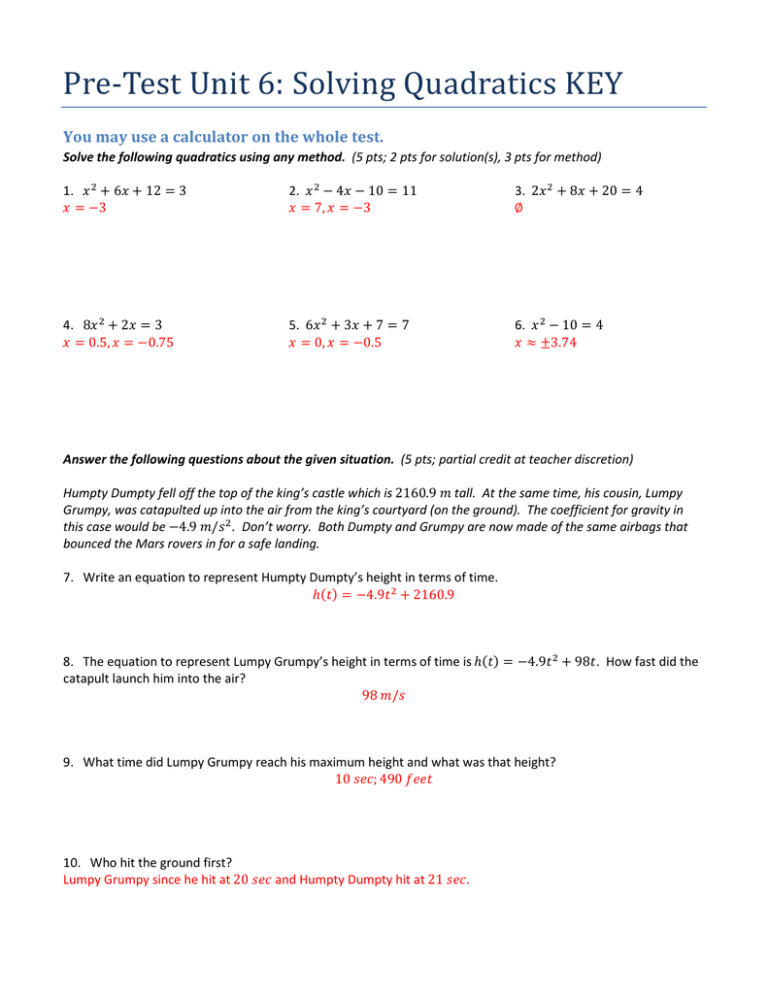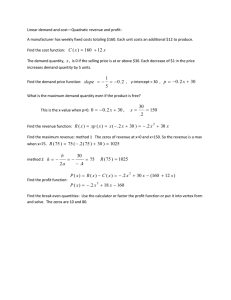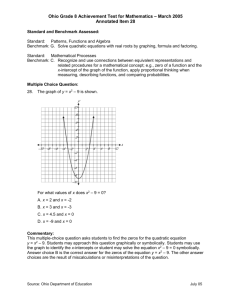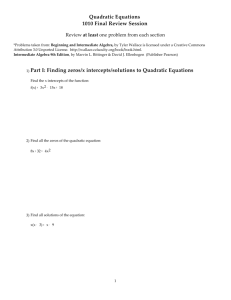Pre-Test Unit 6: Solving Quadratics KEY You may use a calculator on the whole test.
advertisement

Pre-TestUnit6:SolvingQuadraticsKEY You may use a calculator on the whole test. Solve the following quadratics using any method. (5 pts; 2 pts for solution(s), 3 pts for method) 1. + 6 + 12 = 3 = −3 2. − 4 − 10 = 11 = 7, = −3 3. 2 + 8 + 20 = 4 ∅ 4. 8 + 2 = 3 = 0.5, = −0.75 5. 6 + 3 + 7 = 7 = 0, = −0.5 6. − 10 = 4 ≈ ±3.74 Answer the following questions about the given situation. (5 pts; partial credit at teacher discretion) Humpty Dumpty fell off the top of the king’s castle which is 2160.9tall. At the same time, his cousin, Lumpy Grumpy, was catapulted up into the air from the king’s courtyard (on the ground). The coefficient for gravity in this case would be −4.9/ . Don’t worry. Both Dumpty and Grumpy are now made of the same airbags that bounced the Mars rovers in for a safe landing. 7. Write an equation to represent Humpty Dumpty’s height in terms of time. ℎ = −4.9 + 2160.9 8. The equation to represent Lumpy Grumpy’s height in terms of time is ℎ = −4.9 + 98. How fast did the catapult launch him into the air? 98/ 9. What time did Lumpy Grumpy reach his maximum height and what was that height? 10; 490 10. Who hit the ground first? Lumpy Grumpy since he hit at 20 and Humpty Dumpty hit at 21. Solve the following systems using any method. (5 pts; 2 pts for solution(s), 3 pts for work) " = − 2 3 " 3 0,3 and 3,6 " 5 7 12. ! " 2 6 2, 2 and 6,6 " 10 32 13. ! " 6 16 4,8 " 3 2 1 14. ! " 2 11 ∅ 11. ! Solve the following quadratic inequalities in one variable and graph the solution set on the number line. (5 pts; 1 pt for graphing answer, 2 pts for inequality answer, 2 pts for work) 15. 2 15 # 0 3 # # 5 17. ( 9 # 3&' ( 3 16. 6 16 $ 0 % 8&' $ 2 Solve the following quadratic inequalities in two variables by graphing on the coordinate plane. The tables are provided to help you graph if you want to use them. (5 pts; 2 pts for correct parabola, 1 pt for dotted/full, 2 pts for shading) 18. " % 8 8 " 20. " # 4 7 " 19. " ( 4 " Unit 6 Homework Key Lesson 6.1 Solve the following quadratic equations using any method. 1. 6 = 10 = ±2 2. − − 2 = 28 = −5, 6 3. − 12 + 12 = −24 =6 4. − 6 − 7 = 9 = −2, 8 5. − 21 = 4 = ±5 6. − 3 − 4 = 6 = −2, 5 7. − 14 + 55 = 6 =7 8. + 21 = −4 no real solution 9. + 2 − 12 = 10 = ±√23 − 1 ≈ −5.80, 3.80 10. 2 − 16 + 10 = −20 = 3, 5 11. 4 − 11 = 25 = ±3 12. 3 − 9 − 9 = 21 = −2, 5 13. − 8 − 9 = −28 no real solution 14. − 13 = 2 = ±√15 ≈ ±3.87 15. + 6 + 12 = 8 = ±√5 − 3 ≈ −5.24, −0.76 16. 2 − 4 + 2 = 16 = ±√8 + 1 ≈ −1.83, 3.83 17. + 5 + 4 = + 7 = ±√7 − 2 ≈ −4.65, 0.65 18. + 10 = 2 + 9 = −9, 1 19. + 4 = −4 = −2 20. + 4 − 5 = + 13 = −6, 3 21. + 5 = + 2 + 9 =3 22. − 8 + 2 = −10 = 2, 6 23. 3 − 6 − 10 = + 4 + 2 = −1, 6 24. + 12 = 2 − 9 = −9, −1 25. 2 − 5 − 16 = − 5 = ±4 26. 3 + 2 − 3 = 2 = −3, 1 27. − 3 = + 12 = −2, 6 Lesson 6.2 Solve the following quadratic equations using any method. 1. 3 + 2 − 7 = 0 ≈ −1.90, 1.23 2. 3 + 2 + 1 = 2 + 2 no real solution 3. 4 − 484 = 0 = ±11 4. − 4 + 8 = 0 =4 5. 3 − 6 + 11 = 0 no real solution 6. −5 − 6 + 7 = 0 ≈ −1.93, 0.73 7. − = 6 8. + 9 = 3 9. 7 + − 8 = −9 10. 2 − 20 + 25 = −25 =5 11. − 5 + 2 = − 3 = 1, 5 12. 6 − − 1 = 0 * * = −+, * = −2, 3 * ≈ −18.33, 0.33 no real solution Find the ,-coordinate of the vertex and determine how many zeros the quadratic has. 13. 2 − 7 = −1 2 zeros 14. = 2 + 8 + 11 = −2 no zeros 15. = 3 − 6 + 3 =1 1 zero 16. = 2 − 2 + 5 = 0.5 no zeros 17. = 2 − 2 − 4 = 0.5 2 zeros 18. = 2 − 4 + 1 =1 2 zeros 19. = − − − 1 = −0.5 no zeros 20. = − − + 5 = −0.5 2 zeros 21. = −2 − 20 − 50 = −5 1 zero 22. = + 5 − 3 = −2.5 2 zeros 23. = 4 − 8 + 4 =1 1 zero 24. = 3 + 18 + 1 = −3 2 zeros Lesson 6.3 Create equations for the following situations. 1. Vertex: 3,4 Zeros: 3 9 * 3 4 OR * 3 9 2. " 3. 2 1 3 5 4 7 2 4 7 5 5 6 1 - 2 7 5 4. Point: 5, 9 Zeros: 2 6 3 4 12 OR 3 2 6 5. " 6. 2 1 1 4 3 0 9 1 16 2 25 * 4 2 7. Vertex: 7, 4 Point: 3, 8 * 7 4 . 8. " 9. 6 9 5 1 4 7 3 9 2 7 2 3 9 * + 3 9 10. Vertex: 1, 8 Point: 2, 6 2 1 8 11. " 12. 6 5 5 0 4 3 3 4 OR 5 1 3 4 2 3 2 1 8 Answer the following questions about comparing functions. 13. Which type of function will eventually always be growing at the fastest rate: linear or quadratic? Why do you think so? Quadratic; explanations may vary 14. Which type of function will eventually always be growing at the fastest rate: quadratic or exponential? Why do you think so? Exponential; explanations may vary 15. Is it possible for a linear function to be higher than a quadratic function in some spots but lower than the quadratic in others? Sketch an example to the left. Answers will vary Answer the following questions using the given information. To see who was stronger, The Vision and Thor had a throwing contest. They took turns throwing Thor’s hammer straight up into the air, and the winner was the person who kept the hammer in the air longer. Since The Vision has a definite advantage with an infinity gem, he allowed Thor to stand at the top of a cliff 320 in the air before throwing his hammer up at 128 /. The Vision then threw the hammer up at 160 / from the bottom of a hole that was 144 deep. 16. Write an equation to represent the height of the hammer in terms of time when Thor threw the hammer. 16 128 320 17. Write an equation to represent the height of the hammer in terms of time when The Vision threw the hammer. 16 160 144 18. When did Thor’s throw reach a maximum height and what was that height? The hammer reached a maximum height of 576 after 4 seconds. 19. When did The Vison’s throw reach a maximum height and what was that height? The hammer reached a maximum height of 256 feet after5 seconds. 20. When did Thor’s throw hit the ground? After 10 seconds 21. When did the Vision’s throw hit the ground? Why are there two solutions and which one is right? Hulk started below ground, so his hammer reached ground level on its way up after 1 second and returned to the ground after 9 seconds. The correct solution for when it hit the ground is 9 seconds. Sam and Pam had were throwing rocks into a pond. Sam threw from the ground at a speed of 24.5 m/s. Pam threw from a ledge 4.9 meters above the ground at a speed of 19.6 m/s. 22. Write an equation to represent the height of the rock in terms of time when Sam threw. 4.9 + 24.5 23. Write an equation to represent the height of the rock in terms of time when Pam threw the rock. ℎ = −4.9 + 19.6 + 4.9 24. When did Sam’s throw reach a maximum height and what was that height? The rock reached a maximum height of 30.625 meters after 2.5 seconds. 25. When did Pam’s throw reach a maximum height and what was that height? The rock reached a maximum height of 24.5 feet after2 seconds. 26. When did Sam’s throw hit the ground? After 5 seconds 27. Approximately when did Pam’s throw hit the ground? Why are there two solutions and which one is right? There are two zeros for the parabola, however the first zero is before the rock was thrown; thus, it doesn’t make sense in the context of the problem. The correct solution for when the rock hit the ground is approximately 4.24 seconds. Lesson 6.4 Solve the following systems of equations using any method. " " 2 + 3 −3, 9; 1, 1 1. ! 4. ! " = − + 4 − 5 " = − + 2 No solution 7. / " = − 4 + 8 * "= No solution −5 " = 10. ! " = −2 0, 0 " = " =+6 −2, 4; 3, 9 2. ! * " = − 2 + 7 + " = − + 7 0,7; 3, 4 5. / " = − 3 − 4 " = −4 3, −4 3. ! 6. ! " = − 7 + 1 19 + 3" = 11 . *0; - − + , 2, −9 8. ! " = 2 − + 1 2 + 7" = −42 No solution 9. ! " = + 2 − 3 11. ! " = + 2 + 5 No solution " = + 2 − 4 12. ! " = + 4 + 2 −3, −1 " = + 8 + 8 " = + 4 − 3 "=9 −6, 9; 2, 9 " = + 3 13. ! " = 2 + 3 − 9 −3, 0, 3, 18 14. / * " = . + 2 + 2 −1.17, 0, −6.83, 0 " = − 5 15. ! " = 3 + 4 − 5 −2, −1, 0, −5 " = − 6 + 2 16. ! " = − 10 + 36 1, 27 " = + 2 − 1 17. ! " = + 11 2, 15 " = − − 3 + 4 18. ! " = − 6 + 5 1, 0, 5, 0 Lesson 6.5 Solve the following quadratic inequalities in one variable and graph the solution set on the number line. 1. 4 3 # 0 1##3 2. 6 7 $ 0 % 7, $ 1 3. 2 8 9 % 3 1%%3 4. 2 5 ( 2 + ( 3, # 3 (OR 1 3) 5. 4 4 ( 0 # 2, ( 2 (OR 1 2) 6. 8 21 # 4 No solution 7. 8 9 % 8 No solution 8. 6 8 $ 1 3 9. 2 5 3 $ 0 + % 1, $ 10. 2 8 % 10 5 % % 1 * 11. 3 4 # 0 4 # # 1 12. 7 4 ( 4 # 1, ( 8 13. 5 % 1 3 % % 2 14. 2 5 $ 4 ∞, It’s always above a height of 4 15. 2 6 $ 8 % 4, $ 1 16. 3 % 3 0 Lesson Lesson 6.6 Solve the following quadratic inequalities in two variables by graphing on the coordinate plane. The tables are provided to help you graph if you want to use them. 1. " # 4 3 " 2. " ( 6 " 3. " ( 4 4 " 4. " # 8 " * 5. " # 4 5 " 6. " ( 5 6 " 7. " % 4 " 8. " $ 2 3 " 9. " $ 4 " 10. " % 8 " 11. " $ 2 6 5 " 12. " % 1 8 " ReviewUnit6:SolvingQuadraticsKEY You may use a calculator. Solve the following quadratics using any method. 1. 4 + 7 = 4 = −3, −1 2. − 8 + 5 = 2 ≈ 0.39, 7.61 3. 3 + 6 − 24 = 0 = −4, 2 4. 5 + 15 = 5 ≈ −3.30, 0.30 5. 4 + 10 − 9 = −2 ≈ −3.07, 0.57 6. − 3 = 12 ≈ −3.87, 3.87 7. − 3 + 3 = 13 = −2, 5 8. 4 − 7 + 10 = 8 ≈ 0.36, 1.39 9. 4 + 5 = 1 ≈ −1.43, 0.18 10. 3 + 3 + 5 = 11 = −2, 1 11. + 7 = 32 = −5, 5 12. − 9 = −8 = 1, 8 Answer the following questions about the given situation. Batman jumped off of Sears Tower which is 527 meters tall. At the same time, Catwoman was catapulted up into the air from Millennium Park (on the ground). The coefficient for gravity in this case would be −4.9/ . 13. Write an equation to represent Batman’s height in terms of time. 4.9 + 527 14. The equation to represent Catwoman’s height in terms of time is ℎ = −4.9 + 58.8. How fast did the catapult launch her into the air? 58.8343567 15. What time did Catwoman reach her maximum height and what was that height? She reached a maximum height of 176.4 meters after 6 seconds 16. Who hit the ground first? Batman; he hit the ground after ≈ 10.37 seconds and Catwoman hit the ground after 12 seconds Solve the following systems using any method. " 5 14 " 7 1, 8, 7, 0 " 2 5 18. ! " 1 3, 4, 0, 1 " 5 10 19. ! " 2 2, 4 " 2 3 1 20. ! " 3 2 No solution " 4 6 21. ! " 4 6 4, 6, 0, 6 " 4 3 17. ! 22. / * " 3 5 No solution Solve the following quadratic inequalities in one variable and graph the solution set on the number line. 23. 4 12 # 0 24. 5 4 $ 0 25. % 25 26. 6 ( 9 2 # # 6 5 # # 5 % 4; $ 1 # 3; ( 3 (OR 1 3) Solve the following quadratic inequalities in two variables by graphing on the coordinate plane. The tables are provided to help you graph if you want to use them. 27. " % 6 7 28. " $ 3 29." # 2 4 30." # 2 8 " " " "







